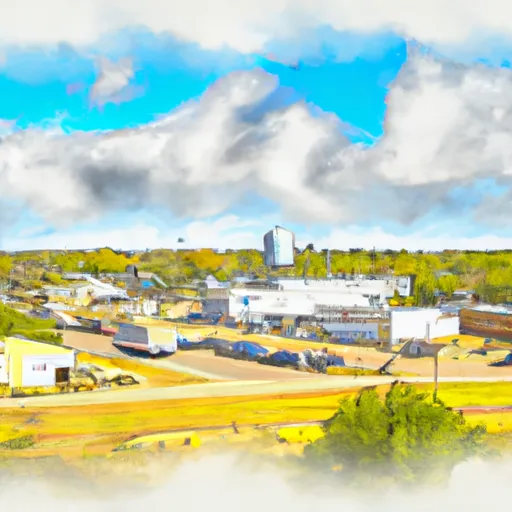-
 Snoflo Premium
Snoflo Premium
Get unlimited access to all our content
With no Ad interruptions! - Start Your Free Trial Login with existing account
Wilburton
Eden Index
Climate
8.1
•
Recreation
2.3
•
Community
1.8
•
Safeguard
4.5/10

Wilburton, Oklahoma, located in Latimer County, is a small town with a population of approximately 2,900 people. The town experiences a humid subtropical climate, characterized by hot, humid summers and mild winters. Average high temperatures in the summer reach around 90°F (32°C), while winter temperatures average around 50°F (10°C). Precipitation is evenly distributed throughout the year, with an annual average of 48 inches, including some snowfall during the winter months.
Hydrologically, Wilburton is situated near the Kiamichi River, providing a scenic backdrop and recreational opportunities. The river, along with local lakes and reservoirs, offers opportunities for fishing, boating, and water sports. Outdoor enthusiasts can explore the area's natural beauty by visiting Robbers Cave State Park, just a few miles south of Wilburton. This park offers hiking trails, rock climbing, camping, and picnicking facilities.
Overall, Wilburton, Oklahoma offers a moderate climate, diverse hydrology constituents, and a range of outdoor recreation opportunities, making it an appealing destination for nature lovers and outdoor enthusiasts.
What is the Eden Index?
The Snoflo Eden Index serves as a comprehensive rating system for regions, evaluating their desirability through a holistic assessment of climate health, outdoor recreation opportunities, and natural disaster risk, acknowledging the profound impact of these factors on livability and well-being.
Climate Health Indicator (CHI): 8.1
Wilburton receives approximately
1210mm of rain per year,
with humidity levels near 85%
and air temperatures averaging around
17°C.
Wilburton has a plant hardyness factor of
7, meaning
plants and agriculture in this region tend to thrive during the non-winter months.
By considering the ideal temperature range, reliable water supplies, clean air, and stable seasonal rain or snowpacks, the Climate Health Indicator (CHI) underscores the significance of a healthy climate as the foundation for quality living.
A healthy climate is paramount for ensuring a high quality of life and livability in a region, fostering both physical well-being and environmental harmony. This can be characterized by ideal temperatures, reliable access to water supplies, clean air, and consistent seasonal rain or snowpacks.
Weather Forecast
Streamflow Conditions
Robert S. Kerr Reservoir
Area Rivers
Robert S. Kerr Reservoir
Snowpack Depths
Robert S. Kerr Reservoir
Reservoir Storage Capacity
Robert S. Kerr Reservoir
Groundwater Levels
Recreational Opportunity Index (ROI): 2.3
The Recreational Opportunity Index (ROI) recognizes the value of outdoor recreational options, such as parks, hiking trails, camping sites, and fishing spots, while acknowledging that climate plays a pivotal role in ensuring the comfort and consistency of these experiences.
Access to outdoor recreational opportunities, encompassing activities such as parks, hiking, camping, and fishing, is crucial for overall well-being, and the climate plays a pivotal role in enabling and enhancing these experiences, ensuring that individuals can engage in nature-based activities comfortably and consistently.
Camping Areas
| Campground | Campsites | Reservations | Toilets | Showers | Elevation |
|---|---|---|---|---|---|
| Jack Guthrie Park - Monticello Reservoir | None | 414 ft | |||
| Lake Winnsboro North Park | 15 | 441 ft | |||
| Lake Hawkins County RV Park | 50 | 366 ft | |||
| Lake Quitman Park | None | 414 ft | |||
| Fish Hawke Point | None | 359 ft | |||
| Governor Jim Hogg RV Park - Quitman | None | 394 ft | |||
| Winnsboro City RV Park | 20 | 495 ft | |||
| Overlook Park - Lake Cypress Springs | None | 390 ft | |||
| Twin Oaks Park - Lake Cypress Springs | None | 387 ft | |||
| Walleye Park - Lake Cypress Springs | 100 | 430 ft |
Nearby Fishing
Catastrophe Safeguard Index (CSI):
The Catastrophe Safeguard Index (CSI) recognizes that natural disaster risk, encompassing floods, fires, hurricanes, and tornadoes, can drastically affect safety and the overall appeal of an area.
The level of natural disaster risk in a region significantly affects safety and the overall livability, with climate change amplifying these risks by potentially increasing the frequency and intensity of events like floods, fires, hurricanes, and tornadoes, thereby posing substantial challenges to community resilience and well-being.
Community Resilience Indicator (CRI): 1.8
The Community Resilience Indicator (CRI) recognizes that education, healthcare, and socioeconomics are crucial to the well-being of a region. The CRI acknowledges the profound impact of these elements on residents' overall quality of life. By evaluating educational resources, healthcare accessibility, and economic inclusivity, the index captures the essential aspects that contribute to a thriving community, fostering resident satisfaction, equity, and social cohesion.

